(November 1952 – January 1953, Black Magic #18 – #20)
It looks like once again I have slipped up. I meant to mention, at the appropriate time, Simon and Kirby’s new title Strange World of Your Dreams. Well the time should have been during the last chapter (Chapter 6) because the first issue of SWYD has the cover date of August 1952. I have previously debated with myself whether to include SWYD in this serial post. While SWYD shares some characteristics with the horror genre and with Black Magic in particular, the title is in other ways quite unique. In the end I had decided not to include it because I have posted on it previously (Strange World of Your Dream, strange indeed and Featured Cover, Strange World of Your Dreams #2). However those posts did not include a discussion of the work by the participating artists so I have added a checklist (Stange World of Your Dreams Checklist) which can also be found in the sidebar. It was a short-lived title which with the last issue cover dated January 1953, the month that this chapter ends with. Black Magic was successful but that does not mean that every title that Simon and Kirby came up with would be as well.
In some earlier chapters of Little Shop of Horrors I have commented on the relatively decreased roll that Jack Kirby’s played in Black Magic. However in my last chapter I remarked on his greater contribution having taken the position of the second most prolific artist. In the period covered here Jack takes the first place with 25 pages. This is really not quite as significant as it might sound because Bob McCarty(?) takes second place with only 2 less page then Jack. However the two have a substantial lead over George Roussos (14 pages). All other artists provided only minor contributions. Surprising that includes the normally prolific Mort Meskin.
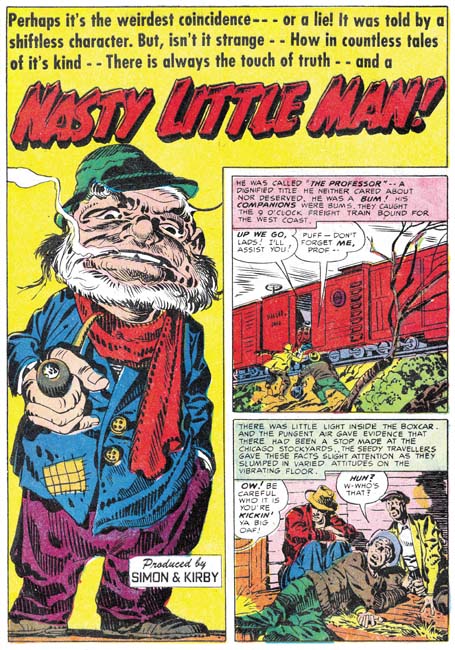
Black Magic #18 (November 1952) “Nasty Little Man”, art by Jack Kirby
Jack Kirby’s contribution to Black Magic during this period has not only increased in amount of art but also played a more prominent part; Kirby did the first, or featured, story for all three issues. One of the stories, “Nasty Little Man”, is in my opinion one of the best pieces Kirby did for Black Magic. The splash is another example of how Jack could make a masterpiece out of virtually nothing. All we are presented with is a standing man that is smoking a pipe. His large head clues us to the fact that he is the little man mentioned in the title. And what a nasty man the story shows that he is. A warning to never underestimate someone based on height.
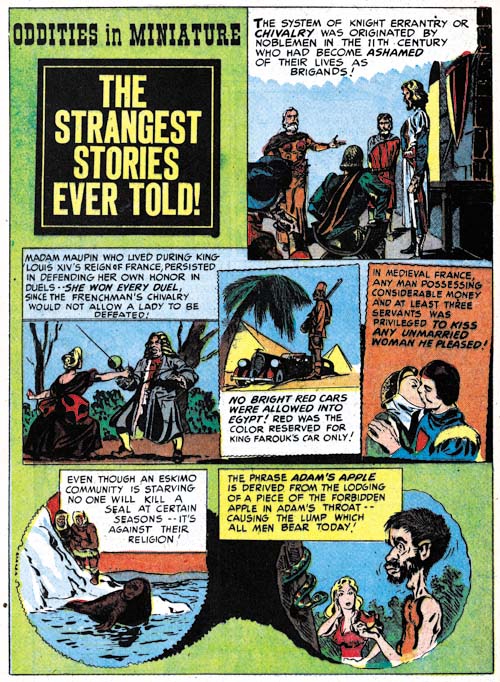
Black Magic #20 (January 1953) “The Strangest Stories Ever Told”, art by Jack Kirby
While I often highlight Kirby’s more substantial contributions it is important to realize that Jack drew rather minor works as well. Sometimes despite their short length these could be masterpieces. However occasionally these short pieces could be all too easily overlooked as was certainly the case for “The Strangest Stories Ever Told”. This work is not included in the Jack Kirby Checklist and in all honesty I had previously failed to recognize it as well. For me the most obvious clue as to the correct attribution is found in the final panel and particularly in the woman. I feel that once the rest of the panels are examined more carefully they reveal Kirby’s hand as well.
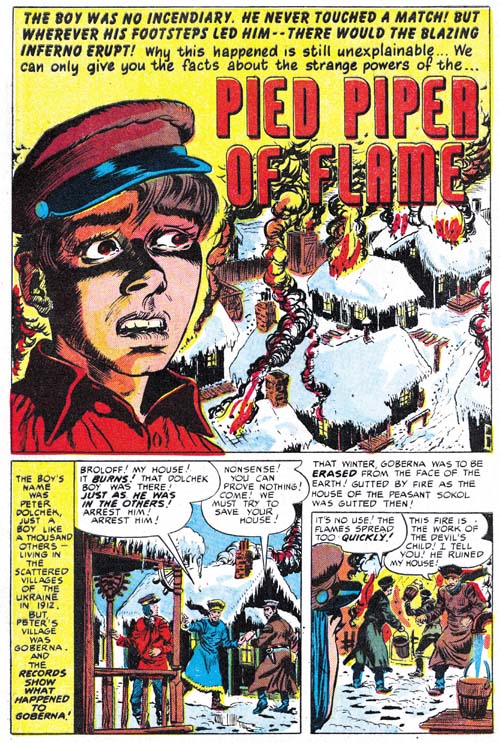
Black Magic #20 (January 1953) “Pied Piper of Flame”, art by Bob McCarty(?)
As I mentioned earlier Bob McCarty(?) plays an important part in these issues of Black Magic. I guess I find that a little surprising since the large eyes that he provides his characters of both sexes give them a rather soulful look that seems a little out of place in the horror genre. That aside, McCarty was certainly good at graphically telling the stories.
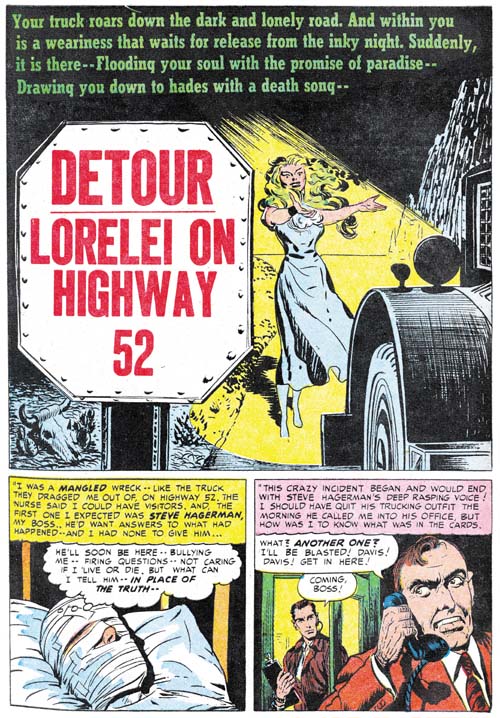
Black Magic #18 (November 1952) “Detour, Lorelei on Highway 52”, art by Bob McCarty(?) and Jack Kirby
Bob McCarty(?) may have been talented but his work was, like that of many of the studio artists, subjected to the inclusion of parts by Jack Kirby. In his perhaps unofficial roll as art editor Jack was sometimes called to touch up another artist’s work. Parts drawn by Kirby occur so often in the splash that the possibility remains that this is not so much a touching up as a preplanned activity. In “Detour, Lorelei on Highway 52” we can see Kirby’s distinctive hand in both the penciling and inking. The entire female figure was done by Kirby and his blunt inking brush can also be seen in some of the nearby road side. However all the foreground elements were inked with a finer brush presumably by McCarty. I am uncertain who did the inking of the background steep hill.
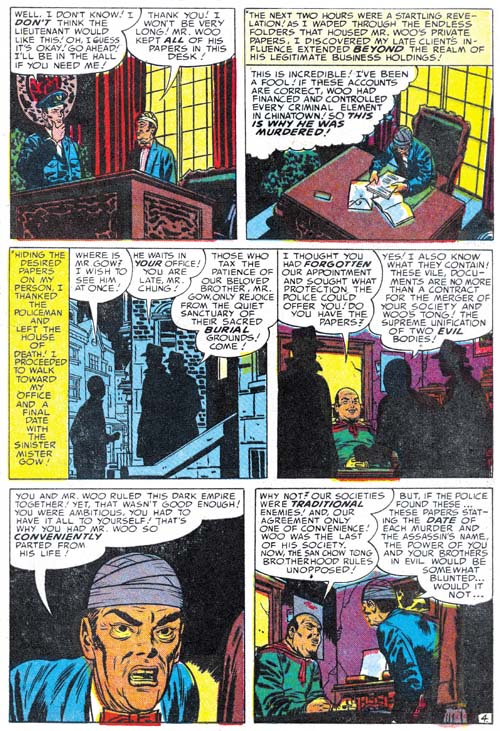
Black Magic #20 (January 1953) “Hatchet Man” page 4, art by Bill Draut
Bill Draut only did a single Black Magic story during this period. Actually it might easily be overlooked because much of the story is drawn from a more distant viewpoint. This is unusual because Draut is generally very good and using more varied viewing distance to keep the story visually interesting. Further the splash panel is one of his poorer efforts so I have decided to deviate from the normal splash page example and show a story page instead. Bill’s hand is particularly easy to spot in the fifth panel.
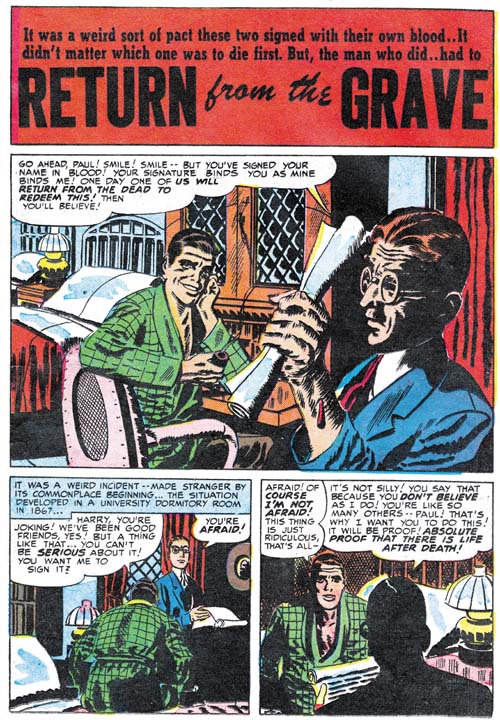
Black Magic #19 (December 1952) “Return from the Grave”, art by Mort Meskin
Mort Meskin also only provides a single story and it is also not one of his better efforts. I believe most of the fault lies in the inking. While there are some effective spotting in parts most of the inking lacks Mort’s typical control and seems a bit crude. I have not been able to come to a conclusion of whether Meskin himself did the inking or some other artist like George Roussos.
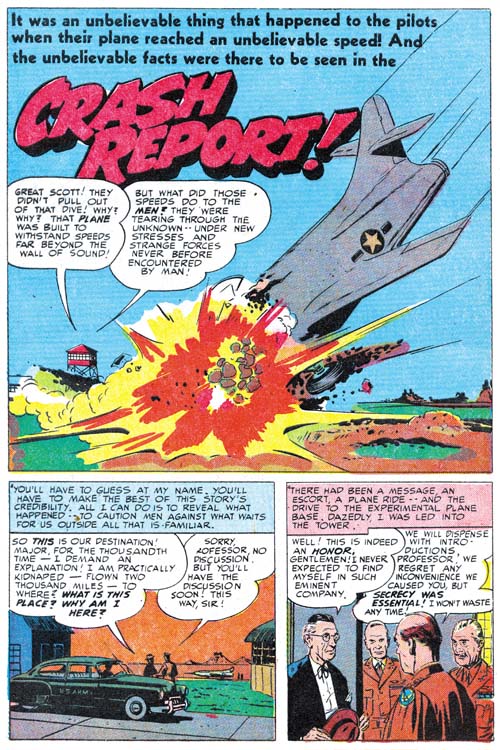
Black Magic #20 (January 1953) “Crash Report”, art by John Prentice
The most pleasant surprise is the return of John Prentice. While Prentice plays an important part in the romance titles he is much less frequently used in Black Magic. I feel John does a great job in his horror genre stories but I suspect that his romance work was so appreciated by Simon and Kirby that they preferred to assign him romance pieces.
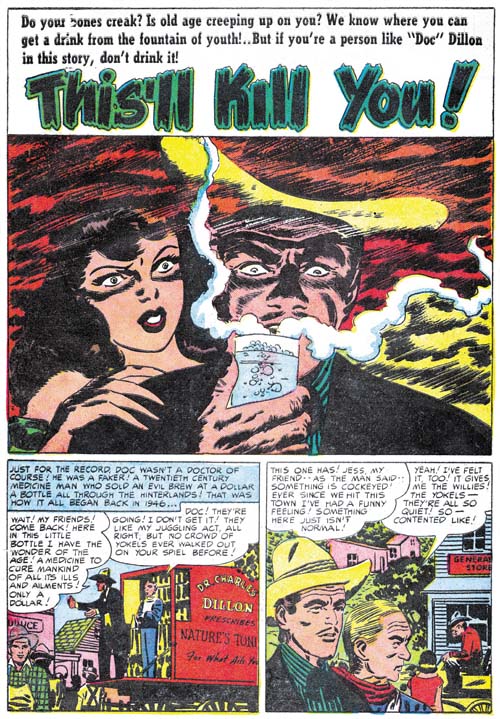
Black Magic #19 (December 1952) “This’ll Kill You”, art by George Roussos
George Roussos provides some work where some of the people have a Meskin look to them. While it is possible that Mort actually had a hand in this art, I am presently interpreting it as Meskin influencing George rather then actually working on the art. This opinion is largely based on some Meskin art that was inked by Roussos without George being so heavy handed as to make it difficult to recognize Mort’s pencils.
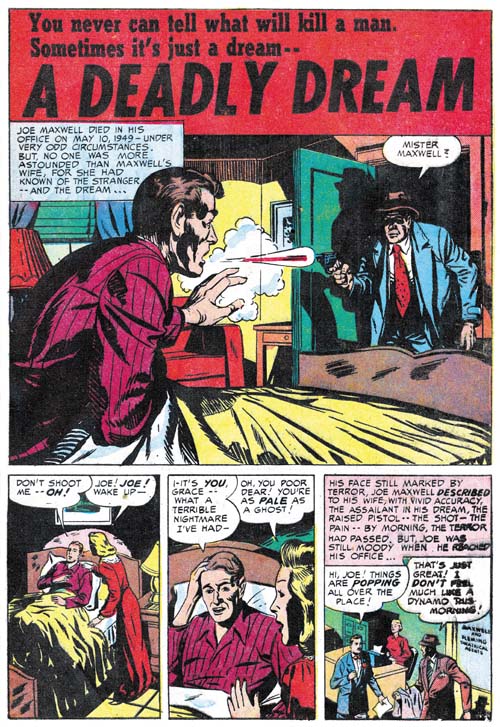
Black Magic #18 (November 1952) “A Deadly Dream”, art by J. G.
Two very short works (one and two pages) resemble the work of a still unidentified artist that signed a piece as J. G. (BM #9, February 1952, “The Man In The Judge’s Chair”). The splash for “A Deadly Dream” includes some picket fence crosshatching and some abstract arch shadow (see Inking Glossary) that are part of the Studio Style inking. Such techniques are not found elsewhere in the story and so they indicate someone, probably either Simon or Kirby, touching up the splash.

Black Magic #19 (December 1952) “Dead Man’s Isle”, art by Bill Walton
Bill Walton also provides a single story during this period. I feel there is no reason to write in more detail about this piece but I do think it helps to provide examples of all the more important artists that work for Simon and Kirby.
The Little Shop of Horrors, Chapter 1 (#1 – 3), Expanding Their Fields
The Little Shop of Horrors, Chapter 2 (#4 – 6), Up and Running
The Little Shop of Horrors, Chapter 3 (#7 – 8), The Same Old Gang
The Little Shop of Horrors, Chapter 4 (#9 – 11), Another Hit
The Little Shop of Horrors, Chapter 5 (#12 – 14), New Faces
The Little Shop of Horrors, Chapter 6 (#15 – 17), Mix Bag
The Little Shop of Horrors, Chapter 8 (#21 – 23), The Gang’s All Here
The Little Shop of Horrors, Chapter 9 (#24 – 26), The Party’s Ovetr
The Little Shop of Horrors, Chapter 10 (#27 – 29), A Special Visitor
The Little Shop of Horrors, Chapter 11 (#30 – 33), The End


strangest stories is clearly reused material from Kieby’s time with victor Fox. I hav most of those from Newspaperarchive Both from their first run in the late tgirties and from their later run in the eark forties and coul tr and pinpiont them for you at some laer point.